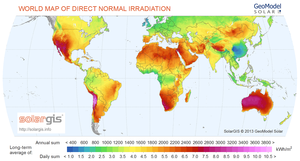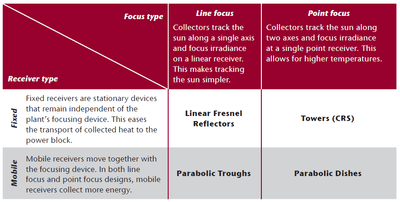Difference between revisions of "Concentrating Solar Power (CSP) - Basics and Introduction"
***** (***** | *****) m |
***** (***** | *****) m |
||
| Line 21: | Line 21: | ||
|} | |} | ||
| − | + | ---- | |
| − | {{#widget:YouTube|id=73SNIuZ333s|height= | + | For a short introduction to Concentrating Solar Power, the idea behind and the general plant design as well as its benefits and obstacles, please feel free to watch the video provided by SolarReserve.<br/> |
| + | |||
| + | {{#widget:YouTube|id=73SNIuZ333s|height=400|width=500}} | ||
= General<br/> = | = General<br/> = | ||
Revision as of 21:09, 17 March 2014
Basics and Technology of CSP
Go back to the < CSP Overview. |
For a short introduction to Concentrating Solar Power, the idea behind and the general plant design as well as its benefits and obstacles, please feel free to watch the video provided by SolarReserve.
General
CSP Systems are replacing fossil fuels with CO2-emission free energy and therefore reduce the overall greenhouse gas emissions. According to Greenpeace the energy pay back time of an CSP plant can amount to just 5 months depending on its configuration and size.[1] CSP Plants can remain in operation for almost 40 years and thus demonstrate its durability and reliability.
Solar Resource
The favourable regions to apply CSP Technology are open for discussion. However, a good indicator to identify CSP potentials is the direct normal irradiation (DNI). Maps can show the distribution of DNI all over the world and thus give a first clue as to where CSP power plants should be built. For further reference please also see the Project Database of CSP Power Plants and overlay the DNI map with it.
Mainly the MENA region, western USA, Southern Africa, Australia and parts of South America.
Generation Costs
Generation costs are currently at reasonable levels and still dropping. They range from 150 US-$/ MWh to 200 US-$/ MWh.[2] The diagram below is taken from the report of the NREL. Hours of TES meaning the thermal storage capacity of the power plant: the time measured in hours that the given power plant can run at rated power output with the storage as its only energy source. The Solar Multiple describes the relation of the installed solar power to the power of the motor block. An over-sized power plant (SM > 1) produces more energy at full solar power intake than the motor can transform. It therefore needs storage facilities to divert the power surplus; otherwise the energy gets spilled.

The SunShot Initiative Concentrating Solar Power Research and Development is trying to reach generation costs of 60 US-$/ MWh by addressing technical barriers for solar fields, receivers and power plants.[3] For more information on levelized cost of energy/ generation costs also see the Cost Analysis of the International Renewable Energy Agency.
Technologies
In CSP power plant design there are four main technologies that are being applied. These technologies have to be picked site-specific and shall be discussed here. A good overview is provided by the International Energy Agency in its Technology Roadmap on Concentrating Solar Power.
Please follow this link to watch a short introduction on Concentrating Solar Power:
CSP technology, being quite different from the more popular photovoltaic equpiment, concentrates sunlight to effectively create heat to raise steam. However, there are different types of technology working under title of CSP. In the following chapters, the idea of the “parabolic trough”, the “power tower”, the “Fresnel mirror system” (or simply “linear Fresnel”) and the “dish” will be presented.
Parabolic Trough
Power Tower
The power tower really lives up to its promise. Compared to other CSP technologies, it can create the highest degree of temperature. Surrounded by mirrors reflecting light onto an elevated and centered tower, the power tower generates heat of about 1,000 C°.[4] By transferring the reflected concentrated solar radiation to a fluid, steam is being produced that expands on a turbine in order generate the intended electricity.[5]
Linear Fresnel
Dish / Engine
Storage Techologies
CSP Today
List of CSP projects
Click here to view, browse and add project information about CSP projects on Energypedia: CSP Projects.
See List of solar thermal power stations and List of concentrating solar thermal power companies (Wikipedia)
References
- ↑ Greenpeacce International - Concentrating Solar Power Global Outlook
- ↑ NREL - Estimating the Performance and Economic Value of Multiple Concentrating Solar Power Technologies in a Production Cost Model
- ↑ SunShot Concentrating Solar Power ResearchfckLRand Development - http://www1.eere.energy.gov/solar/pdfs/55467.pdf
- ↑ Taggart, S. (2008), “Hot Stuff: CSP and the Power Tower”, in: Renewable Energy Focus, May/June 2008, pg. 52
- ↑ Taggart, S. (2008), “Hot Stuff: CSP and the Power Tower”, in: Renewable Energy Focus, May/June 2008, pg. 54






















